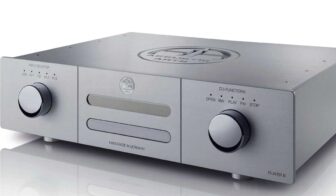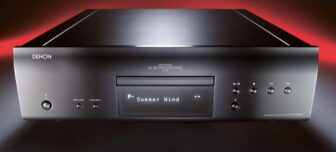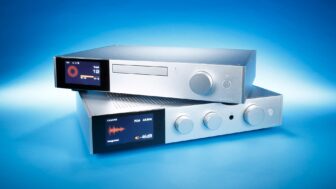McIntosh MCD 12000 AC Review
A superb SACD/CD player with a freely accessible top DAC? Or a reference converter with a built-in SACD/CD drive? With the McIntosh MCD 12000 AC, it’s a question of definition—in other words, differentiation. But once it starts playing, it brings boundless joy.
By Lothar Brandt
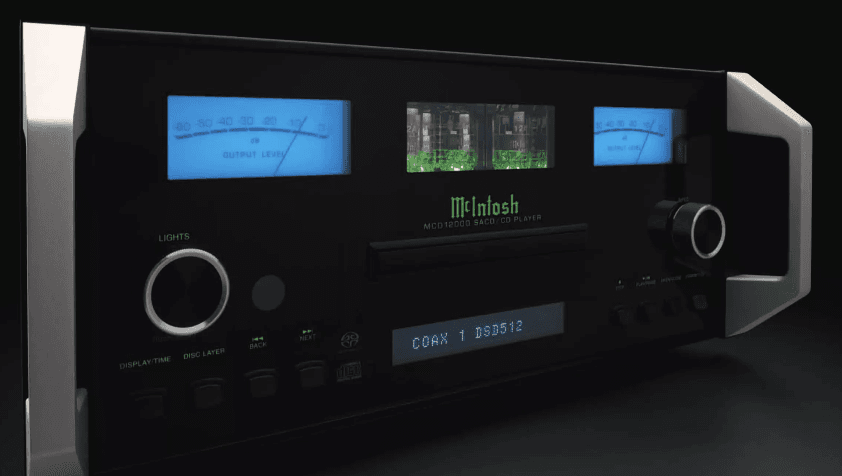
At least the lettering is clear. Under the iconic McIntosh logo, it reads “MCD 12000 SACD/CD Player”. But both the US traditional company founded in 1949 by Frank McIntosh and Gordon Gow and the German distributor Audio Components consider it more appropriate to introduce it as a “reference DAC”, which also masters SACD and CD playback at the highest level.
Naturally, the player appears in the AC version; the distributor includes the obligatory Shunyata power cable and fine-tunes some parameters. And how the MCD 12000 AC performs: almost 20 centimeters high, almost 15 kilograms heavy, and every inch a true McIntosh.
FOR THE SUPER AUDIO CD
With a little help. The SACD/CD drive, in its basic configuration with twin laser, is probably sourced from Denon. After all, from 2003 to 2012, McIntosh, Denon, and Marantz belonged to D&M Holdings. Today, McIntosh is a brand of the McIntosh Group (formerly Fine Sounds Group), which has been part of Highlander Partners’ portfolio in Dallas since June 2022. But the McIntosh Laboratories still reside in Binghamton, New York. And there, they place the drive in a decoupled aluminum chassis and optimize the controlling servo. It is supposed to keep the optics, which read out at double speed, precisely on the ideal track, so that the cleanest possible data is loaded into the buffer and the excellent error correction has to intervene as little as possible from the outset.
McIntosh still relies on the Super Audio CD, and the MCD 12000 even offers a proprietary interface for the in-house, pure SACD/CD drive MCT 500. Sony, along with partners, introduced the SACD at the end of the 1990s to have, firstly, a higher-resolution medium compared to the CD; secondly, an effectively copy-protected one (a huge topic at the time); thirdly, one that could be marketed at a higher price; and fourthly, one capable of multichannel. While the CD format was fixed at Pulse Code Modulation (PCM) with 16-bit word length and 44.1 kHz sampling rate, Sony decided on the higher-resolution Direct Stream Digital (DSD) for the SACD. A variant of the Digital Versatile Disc, for which Sony competitor Philips, by the way, wrote down the data in the so-called Scarlet Book (comparable to the Red Book for the CD). For example, the reading wavelength of the laser of 650 nm (CD: 780 nm). DSD is a one-bit format, defined for SACD at 64 times the sampling rate of the CD, i.e., 2.8224 MHz (DSD 64). Denser tracks and the possibility of multiple layers allow for higher data capacity (between 4.7 and 8.5 GB) than the CD (around 800 MB). On the 12-centimeter disc, there are either only DSD data (Single Layer or Dual Layer when two layers are used, e.g., for stereo and multichannel) or CD and SACD tracks (Hybrid).
FOR HIGHEST RESOLUTIONS
The McIntosh MCD 12000 can only do stereo, but on the converter side with resolutions far beyond SACD.
Ever higher bandwidths have long allowed significantly higher-resolution PCM formats—the USB-B input processes up to 32 bit/384 kHz—and the DSD camp has also upgraded. DSD128 (with 128 times the sampling rate of 44.1 kHz), DSD256, and even DSD512 with 22.58 MHz: also no problem for the big Mac. Then there’s Digital eXtreme Definition (DXD), a kind of hybrid that, put simply, stores high DSD resolutions in high PCM resolutions (24/352.8). Whatever is delivered from the in-house drive or via the seven digital inputs—only hyper-critical professionals will miss a BNC interface—the MCD 12000 processes everything.
It uses as the heart of its, also designated as “Roon Tested”, Digital-Analog Converter the well-regarded DAC chip ESS Sabre 9038 in the Pro version. And not just one of these super-fast eight-channel DACs, but two, one for each stereo channel. ESS calls the internal architecture of its superchips “HyperStream II”, in which a “Time Domain Jitter Eliminator” is supposed to eliminate the dreaded timing jitter in the digital data flow. The theoretically eight outputs per chip are configured by McIntosh in the “octal balanced” mode to a mono signal per channel. This gives the MCD 12000 an almost unsurpassable channel separation, but above all an immense signal-to-noise ratio. To which the strictly separate power supply for the analog and digital sections contributes, for which the massive but highly low-leakage R-core transformer naturally provides separate taps.
WHAT REACHES THE OUTSIDE
What exits externally via each channel through analog outputs is shown on two VU meters spanning over 60 dB. Between them, the Americans place a window behind which four glass tubes glow. After switching on, they illuminate orange, and when ready for operation, they are lit green (like the VU meters, they can be switched off). The double triodes actually amplify the output signal, instead of, as the transistor faction often mocks, merely adding “noise and distortion”. Record-breaking 113 dB signal-to-noise ratio at the tube output speaks for itself. It’s even 1 dB more at the “solid state” outputs, which are driven by symmetrically connected operational amplifiers. The respective XLR outputs are indeed driven symmetrically, that is, with double the voltage compared to the RCA ports. All with fixed level; use as a substitute preamplifier with variable level is not intended in this league.
And it is the very top league in which this McIntosh MCD 12000 AC plays. Whether through tube or transistor output: the music burst almost with life, inner tension, dynamics, and timbres. Above all, however, the playback remained incredibly gripping. The author preferred the XLR tube output, which brought in a bit more “thrill”. But that’s almost a matter of taste. Pure audiophile happiness was definitely provided by the playback of the “Old Hall Ladymass” by Trio Mediaeval—that really made the sun rise—in the literal sense. In the piece “Sol Lucet”, the Mac brought so much light into the highly complex voice leading and the delicate spatial effects that the transparency seemed almost ethereal.
Since this music is one of the few works that are available natively in higher resolutions than SACD, the DAC in the MCD 12000 could prove that it could still add here. Unbelievable, but it became a touch clearer, a bit more differentiated, a little more refined.
But even the SACD playback provided a series of goosebump moments. How majestically the horn theme rose above the string tremolo in the final movement of Sibelius’s Fifth Symphony (BIS). How deeply Paul Simon could ingratiate himself with “Something So Right” (on “There Goes Rhymin’ Simon”, MFSL). How intensely Bob Dylan evoked the “Man With The Long Black Coat” (on “Oh Mercy”, MFSL): That really went deep.
For the heroic highlight in the high-fidelity listening festival, Richard Wagner’s “Siegfried” provided. The SACD reissue of Georg Solti’s legendary Decca recording could really blow you away, sweep you off your feet, elevate you. The notorious “Forging Songs” push every tenor—and hi-fi systems—to the limit. The Mac seemed to know no limits. It let the bellows hiss, the hammer swing, the anvil thunder, the steel clang, the sword flash, and the hero triumph so that even non-Wagnerians succumbed to the sound rush. More emotional impact is not possible.
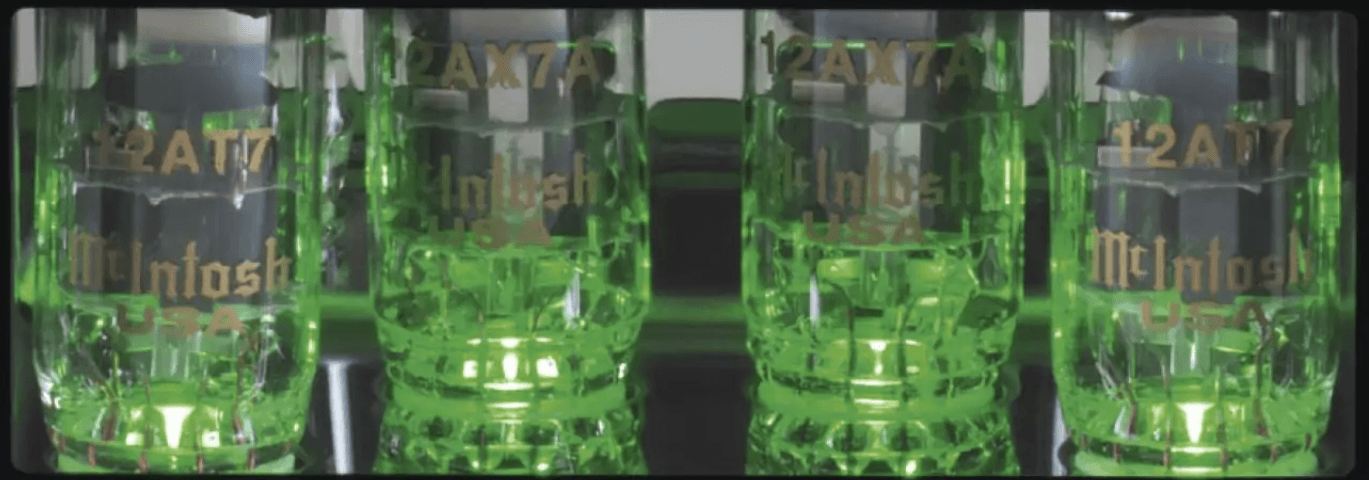

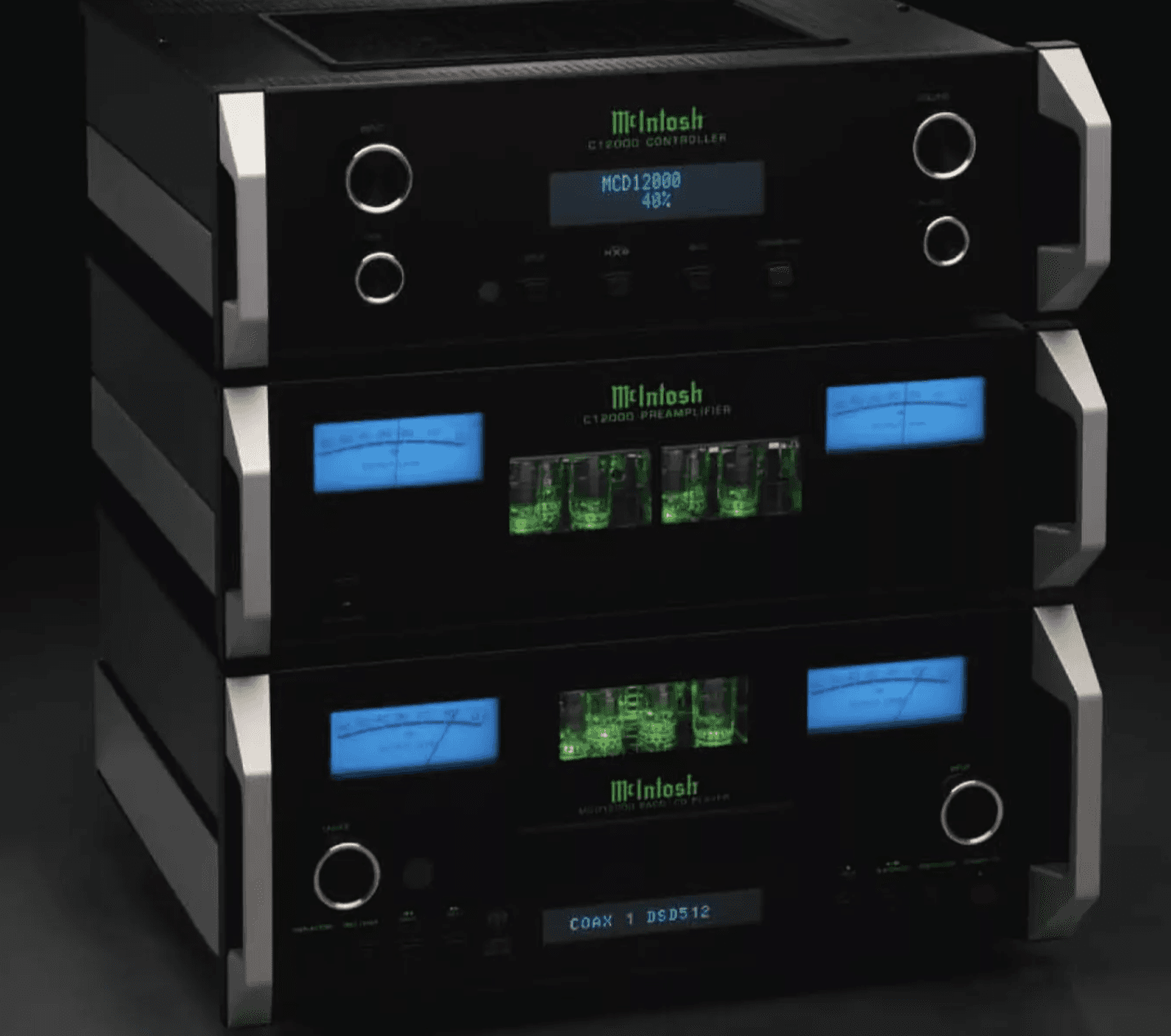
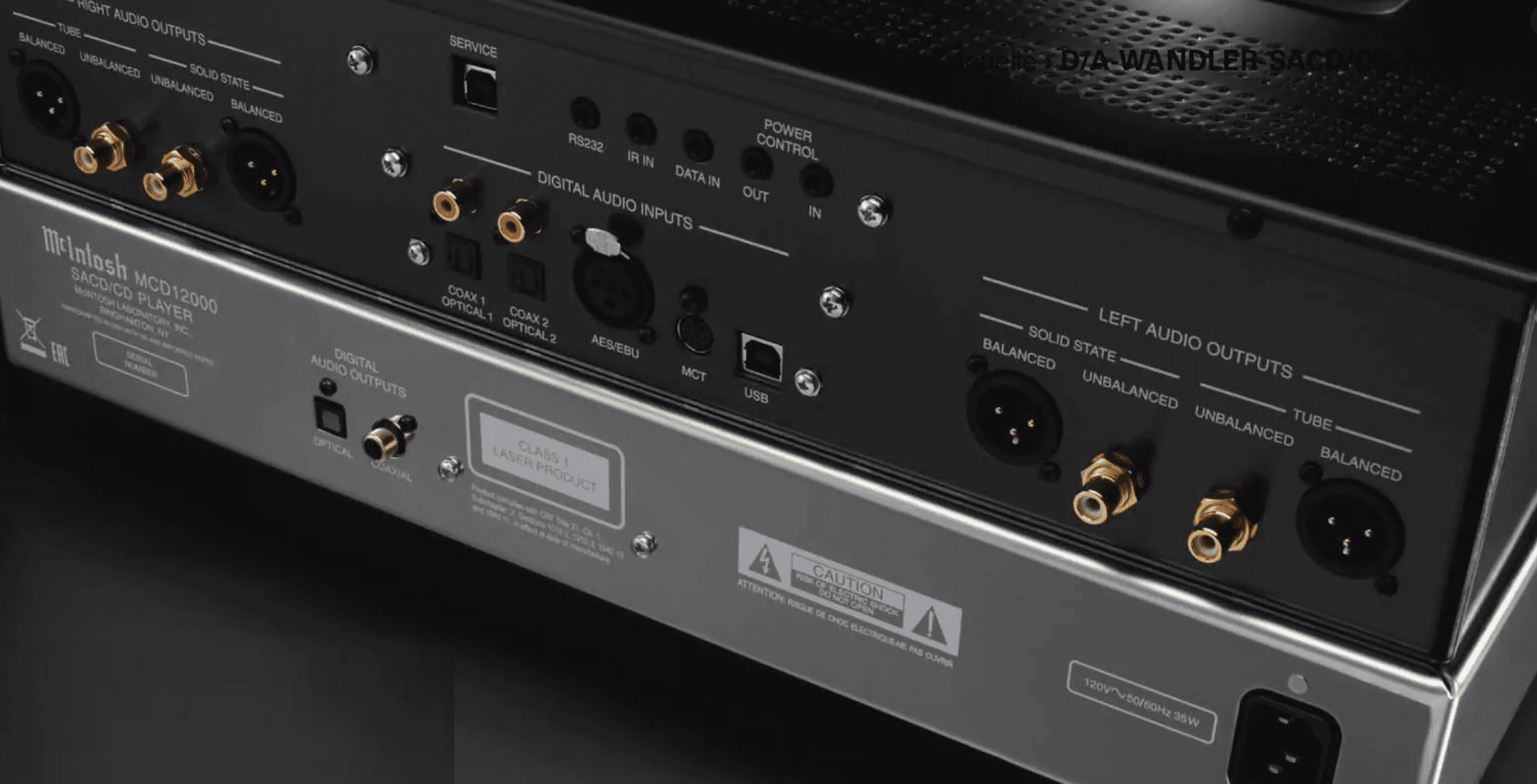
MEASUREMENT LAB
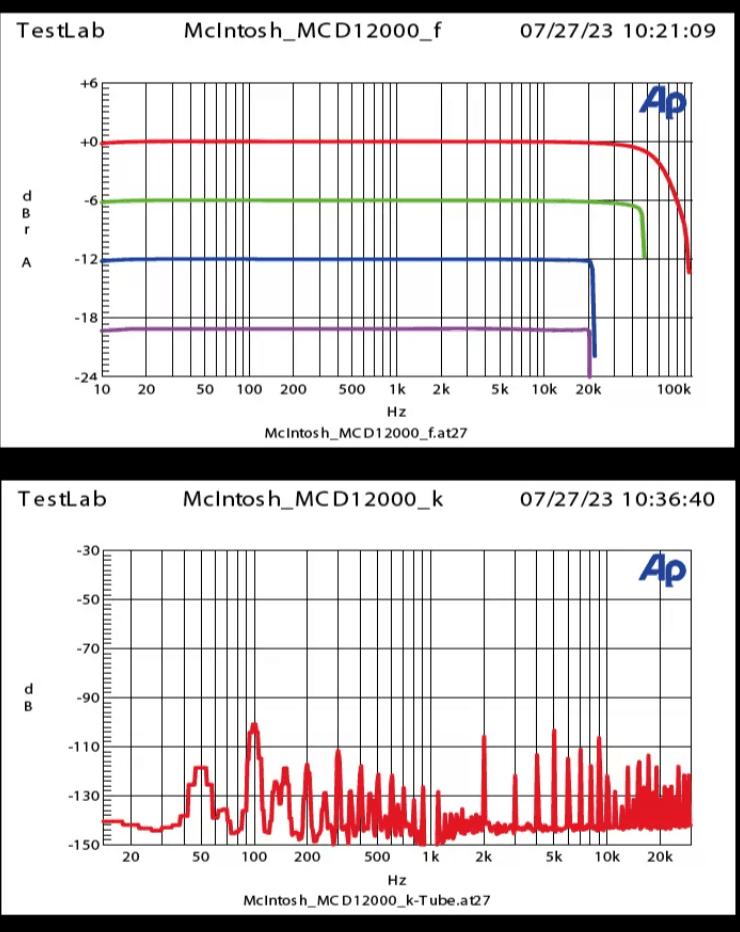
Linear frequency responses in DAC mode (above) with PCM tone 192, 96, and 44.1 kHz and with pre-emphasis-coded audio CDs (above, magenta). The frequency responses are identical in solid-state and tube mode. Lower diagram: Distortion spectrum in DAC mode at 1 kHz (filtered out) and 0 dBFS: extremely low noise floor, from which only very quiet mains hum components (50 Hz multiples) and distortion harmonics (multiples of 1 kHz) emerge. The distortion spectra in transistor and tube mode (not shown) differ only minimally; in both cases, we get an excellently low THD+N value of 0.002% (A-weighted). The signal-to-noise ratios are consistently high; we record negligible but measurable differences depending on output (RCA/XLR), sound mode (transistor/tube), and source (DAC/CD) between 110 and 114 dB (A-weighted). Output level (fixed): 1.8/2.0 V (RCA, DAC/CD) or 3.7/4.0 V (XLR, DAC/CD). Output impedance RCA/XLR 620/1200 Ω (applies to solid-state and tube). Power consumption standby/operation 0.4/46 W.
Specifications:
- Price (MSRP): 15,980 Euros (~$17,400 USD)
- Warranty: 2 years
- Dimensions (W x H x D): 44.5 x 19.4 x 41.6 cm
- Weight: 14.7 kg
Digital Inputs:
- USB / S/PDIF Coax: 1 / 2
- TOSLink / AES/EBU / BNC / MCT: 2 / 1 / – / 1
- Bluetooth / AirPlay: Not available
- HDMI: Not available
Sampling Rates:
- TOSLink: Up to 24-bit / 192 kHz
- Coax: Up to 24-bit / 192 kHz
- USB: Up to 32-bit / 384 kHz
- DSD: Up to DSD 512, DXD
Digital Outputs:
- S/PDIF Coax / TOSLink: Available
Analog Outputs:
- Cinch / XLR: Both available, each with tube and transistor options
Features:
- Random Track Selection: Yes
- Play Time Display (Track/CD/Program): All available
- Remaining Time Display (Track/CD/Program): All available
- Repeat (CD/Track/A–B): All available
- Remote Control: Yes
- Variable/Fixed Output: Fixed
- Parallel Output: Tube/Transistor
- Disc Formats: CD, SACD, Data DVD
- Headphone Output (Adjustable): No
- kHz/Bit Display: Yes/No
- Switchable Filters: No
- Volume Control: No
- Special Features: Tubes, VU meter
Verdict
Again: Super converter with an added SACD/CD drive, or superb SACD/CD player with freely accessible converter section? McIntosh has decided on the first variant with the MCD 12000 AC. I, however, am enthusiastic about a wonderful player. It plays my favorite SACDs and favorite CDs in a quality that has brought the seemingly antiquated silver discs much closer to my heart again. A super converter simply belongs to it.
Audiogram (Review Summary):
Pros:
- Sensationally open, transparent, yet charming sound
Cons:
- No variable output, no headphone jack, high price
Sound (SACD/CD/DAC): 147 / 145 / 148
Evaluation:
Sound:
- SACD: 147 → 9.8/10
- CD: 145 → 9.7/10
- DAC: 148 → 9.9/10
Features: Very Good → 9/10
Usability: Outstanding → 10/10
Build Quality: Outstanding → 10/10
Final Score:
- Sound Rating: 147/145/148 points → 9.8/10 (average)
- Price/Performance: High-end, Outstanding
Is McIntosh MCD12000 really the World Class Digital to Analog Convertor?
Another fascinating unboxing experience with Adrian. Let's reveal the McIntosh MCD12000. Comment below and LET US KNOW ...



